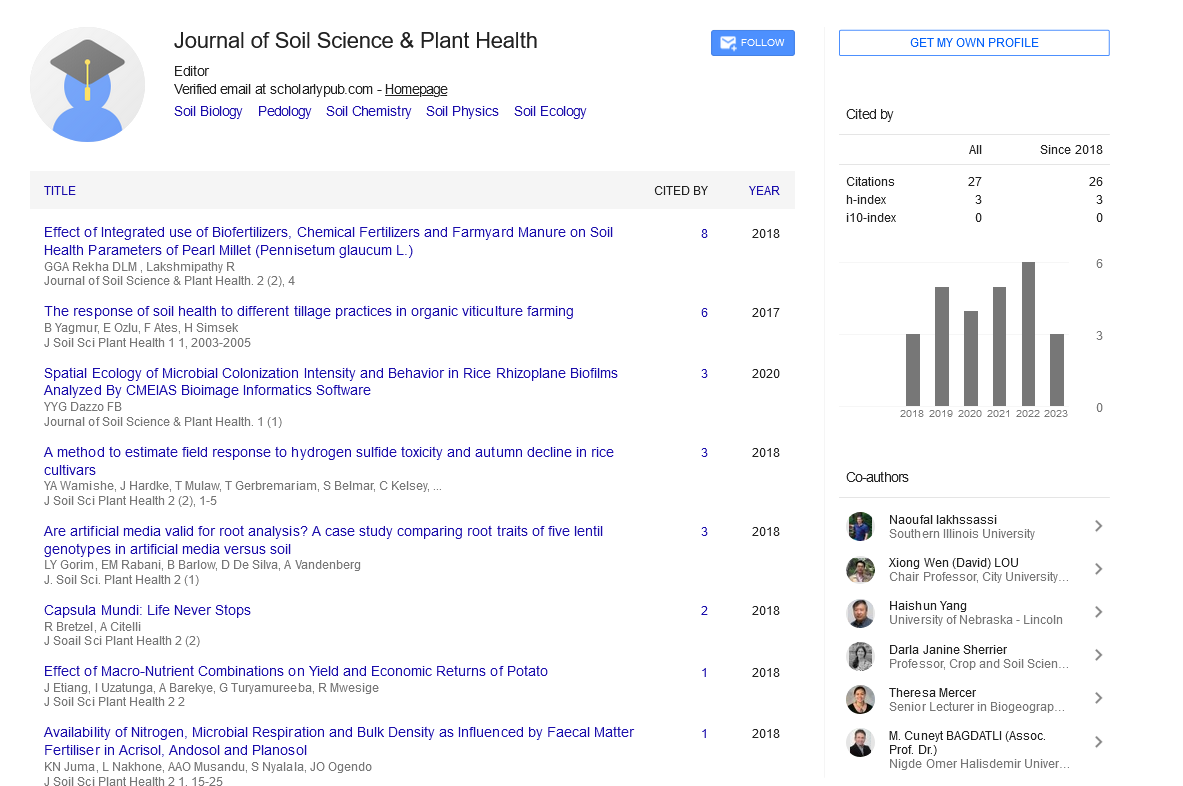Editorial, J Soil Sci Plant Health Vol: -7 Issue: -1
Biosolarization: A Sustainable Approach to Soil Disinfestation
Neelam Duby*
Department of Microbial Ecology, Aligarh Muslim University, India
- *Corresponding Author:
- Neelam Duby
Department of Microbial Ecology, Aligarh Muslim University, India
E-mail: duby957@gmail.com
Received: 01-Feb-2025, Manuscript No. Jsph-25-170158; Editor assigned: 4-Feb-2025, Pre-QC No. Jsph-25-170158 (PQ); Reviewed: 18-Feb-2025, QC No. Jsph-25-170158; Revised: 25-Feb-2025, Manuscript No. Jsph-25- 170158 (R); Published: 28-Feb-2025, DOI: 10.4172/jsph.1000203
Citation: Neelam D (2025) Biosolarization: A Sustainable Approach to Soil Disinfestation. J Soil Sci Plant Health 7: 203
Introduction
In recent years, sustainable agriculture has gained attention due to growing concerns about environmental degradation and food safety. One innovative technique that aligns with these principles is biosolarization—a hybrid method combining traditional soil solarization with the incorporation of organic amendments. Originally developed as an eco-friendly alternative to chemical fumigation, biosolarization uses solar heat and microbial activity to suppress soil-borne pests, pathogens, and weeds while enhancing soil fertility [1]. This method has proven particularly effective in warm climates and is gaining popularity among organic and conventional farmers alike [2].
Discussion
Biosolarization begins by applying organic materials such as compost, manure, or agricultural waste (e.g., tomato pomace, grape pomace, or molasses) to moist soil. The soil is then covered with a transparent polyethylene tarp and exposed to direct sunlight for several weeks. This setup creates a greenhouse-like effect, raising soil temperatures to levels that are lethal to many harmful organisms, including nematodes, fungal pathogens, and weed seeds [3].
What sets biosolarization apart from traditional solarization is the addition of organic matter, which enhances microbial activity. As the organic material decomposes under the tarp, anaerobic fermentation processes are triggered. These processes release volatile compounds—such as organic acids, ammonia, and other bioactive gases—that contribute to the suppression of soil pathogens and pests. Additionally, this decomposition improves soil structure, water retention, and nutrient content, making biosolarization both a pest control method and a soil amendment strategy [4].
Studies have shown that biosolarization is particularly effective when used with locally available waste products, turning agricultural by-products into valuable resources. This not only reduces waste but also lowers input costs for farmers. The process can also be tailored to different crops and soil types, making it a versatile solution for a wide range of farming systems.
However, biosolarization has some limitations. Its effectiveness depends on climatic conditions, particularly temperature and sunlight, making it less feasible in cooler or cloudy regions. It also requires a fallow period, during which the land cannot be cultivated. Moreover, the plastic tarp used can contribute to plastic waste unless biodegradable or recyclable options are employed [5].
Conclusion
Biosolarization represents a promising, environmentally friendly alternative to chemical soil fumigation. By leveraging solar energy and microbial processes, it effectively controls soil-borne pests and diseases while improving soil health. Its ability to recycle organic waste into a valuable resource aligns well with the principles of sustainable and regenerative agriculture. Despite some logistical and climatic constraints, biosolarization holds significant potential for adoption in regions with suitable weather conditions and access to organic amendments. With further research, education, and development of biodegradable materials, biosolarization could become a cornerstone of eco-friendly soil management practices worldwide.
References
- Bejiga G, Tullu A, Tsegaye S, Eshete M, Anbessa Y, et al (1997). Soil surface drainage and yield of chickpeagrownonvertisolsinEthiopia. Afr Crop Sci J. 5(1): 23-29.
- FAO W, (2009). Crop and food supply assessment mission to Ethiopia. Special report, Food and Agricultural Organization of the United Nations (FAO) and World Food Programme (WFP), Rome.
- Hulse JH, (1989). Nature, composition and utilization of grain legumes. Uses of tropical grain legumes. 27-31.
- Ibrikci H, Knewtson SJ, Grusak MA, (2003). Chickpea leaves as a vegetable green for humans: evaluation of mineral composition. Journal of the Science of Food and Agriculture. 83: 945-950.
- Joshi PK, Rao PP, Gowda CLL, Jones RB, Silim SN, et al (2001). The World Chickpea and Pigeonpea Economies Facts, Trends, and Outlook. International Crops Research Institute for the Semi-Arid Tropics. 12: 36-45.
 Spanish
Spanish  Chinese
Chinese  Russian
Russian  German
German  French
French  Japanese
Japanese  Portuguese
Portuguese  Hindi
Hindi 